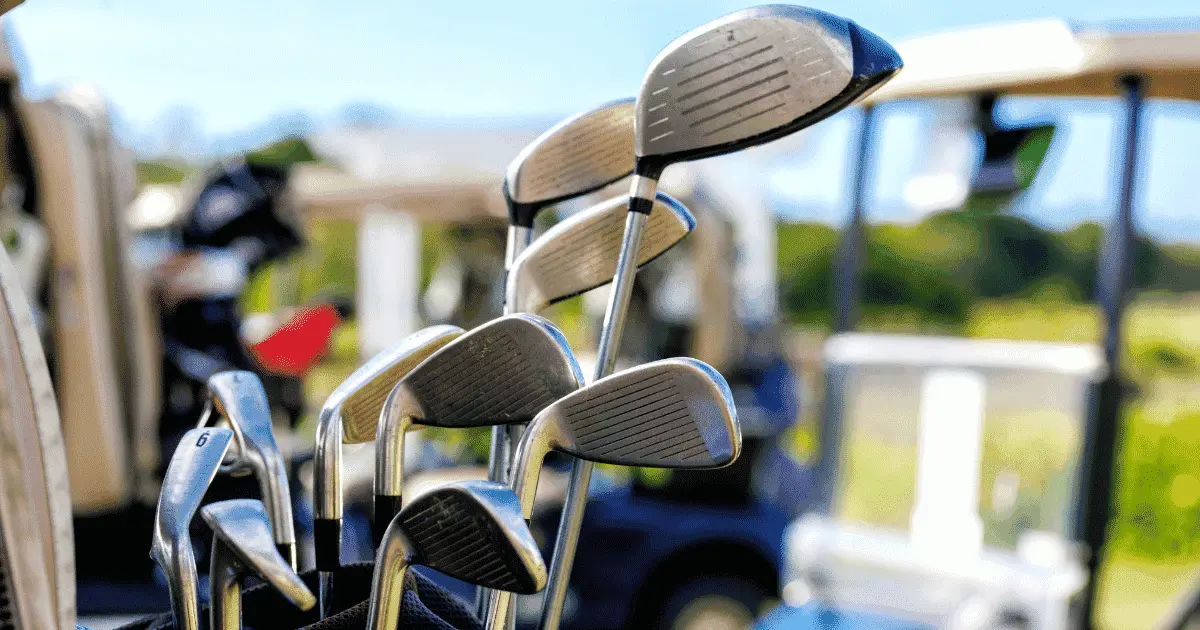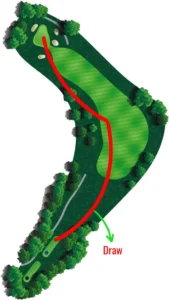When it comes to golf, club selection plays a vital role in determining your success on the course. Choosing the right club can significantly impact your game and help you achieve optimal results.
| Club | Use | Typical Scenarios |
| Driver | Maximum distance off the tee | Par 4s and par 5s where distance is important, starting a hole or reaching a long par 3 |
| Hybrid | Versatile alternative to long irons | Long approach shots from the fairway or rough, difficult lies, replacing long irons for better control |
| 2 to 9 Irons | Varying distances for approach shots | Approach shots to the green, accuracy and control from various distances |
| Wedges | Short game shots and precision | Short approach shots, shots around the green, bunker shots, high trajectory shots, pitching and chipping |
| Putter | Rolling the ball into the hole | On the green for short and precise putts, finishing a hole |
Here’s why club selection is so important:
Shot Distance: Each club in your bag is designed to produce different distances. Selecting the appropriate club allows you to match the shot distance required for a particular hole or situation.
Trajectory Control: The loft of the club influences the trajectory of the shot. Choosing the right loft helps you navigate obstacles and land the ball on the desired target area.
Accuracy and Consistency: Different clubs offer varying levels of forgiveness and control. Picking a club that suits your skill level and playing style enhances accuracy and consistency.
Shot Versatility: A well-equipped golfer understands how to use various clubs to execute different shots, such as high shots to clear obstacles or low shots for better control in windy conditions.
Understanding the Basics of Club Selection
The Role of Loft and Distance
Loft and distance are closely related when it comes to club selection. Understanding this relationship allows you to optimize your shots:
Higher lofted clubs, such as wedges, provide more loft and backspin, resulting in shorter shots with a higher trajectory.
Lower lofted clubs, like drivers or long irons, generate lower trajectories and longer distances, making them ideal for tee shots or long fairway approaches.
The Impact of Clubhead Design
Clubhead design influences shot performance, feel, and forgiveness. Here are some key considerations:
- Cavity-back irons offer a larger sweet spot, providing forgiveness and distance for golfers seeking more forgiveness.
- Blade irons have a smaller sweet spot and offer greater control and workability for skilled players who prioritize precision.
Considerations for Course Conditions

Course conditions have a significant impact on club selection. Adjusting your club selection based on factors such as wind, slope, and ground firmness can optimize your shots:
Wind: When facing a headwind, choose a club with more loft to counteract the wind’s effect. Conversely, with a tailwind, select a lower lofted club to maximize distance.
Slope: Uphill or downhill lies affect the distance and trajectory of your shots. Adjust your club selection to compensate for the slope and maintain accuracy.
Ground Firmness: Firmer or softer ground can influence how the ball reacts upon landing. Consider the firmness of the ground when choosing the appropriate club for your shot.
Analyzing Shot Distances and Club Yardages

Understanding Your Personal Yardages
Accurately measuring your shot distances is essential for effective club selection. Here are techniques to determine your average distances with each club:
Range Sessions: Practice at the driving range and note the average distance achieved with each club.
Launch Monitors: Utilize launch monitors that provide detailed data on shot distances, including carry and total distance.
On-Course Tracking: During rounds, pay attention to your shots and make note of the club used and the resulting distance.
Establishing a Yardage Chart
Creating a personalized yardage chart provides a handy reference tool during your rounds. Follow these steps to map out typical distances for each club:
Take multiple shots with each club under various swing conditions.
Record the average distances achieved, considering factors like swing quality, weather conditions, and terrain.
Create a chart or use a smartphone app to document your yardages, allowing you to make informed club selections on the course.
Fine-Tuning Club Selection for Different Scenarios

Tee Shots and Fairway Approaches
Selecting the right club off the tee and for fairway approaches can significantly impact your game. Consider the following factors:
Distance: Assess the length of the hole and choose a club that provides the desired distance off the tee.
Accuracy: Take into account the fairway width, potential hazards, and landing area. Choose a club that offers both distance and accuracy.
Green Conditions: Evaluate the condition of the green, such as firmness and slope. Select a club that allows for optimal shot trajectory and control.
Golf Short Game Club Selection
The short game, including pitching, chipping, and bunker play, requires precise club selection. Here are some recommendations:
Pitching: Utilize wedges with various lofts to control trajectory and spin. Higher lofts provide shorter, higher shots, while lower lofts offer more roll.
Chipping: Assess the lie, distance to the target, and the desired trajectory. Select a club that allows you to execute the shot with control and accuracy.
Bunker Play: Use a sand wedge with a higher loft to escape bunkers effectively. The loft helps lift the ball out of the sand while generating spin.
Master the Wedges For Short Game
Wedges are the primary clubs used for short game shots.
- Pitching wedge (PW) is ideal for longer chips and pitches.
- Gap wedge (GW) is suitable for mid-range shots.
- Sand wedge (SW) is designed for bunker play.
- Lob wedge (LW) is used for high, soft shots around the green.
Chipping Golf Club Selection
Selecting the appropriate club for chipping depends on various factors. Consider the following:
Lie: Determine whether the ball is sitting up or nestled down in the grass. Choose a club that allows you to make clean contact with the ball.
Green Speed: Take into account the speed of the green and how it affects the ball’s roll. Adjust your club selection accordingly.
Shot Scenario: Different chipping scenarios call for different club choices. For bump-and-run shots, use a lower lofted club, while high, soft lobs require a higher lofted club.
Based on your factors, consider the following club options for chipping around the green:
Putter: If you have a lot of green to work with, the green is fast, or you need to keep the ball on the ground for a longer distance, a putter can be a viable option.
Pitching Wedge: The pitching wedge is a versatile club that can be used for a variety of chip shots. It provides good control, allowing you to hit a variety of trajectories and distances.
Gap Wedge/Sand Wedge: If you need to carry the ball over a hazard or a higher fringe, a gap wedge or a sand wedge can be the right choice. These clubs have more loft, which helps the ball get airborne quickly.
Lob Wedge: The lob wedge is ideal for situations where you need to hit a high, soft shot that stops quickly on the green. Use this club when you have limited green to work with or when you need to get the ball over an obstacle with precision.
Hitting Shots from the Rough
The rough poses unique challenges and requires adjustments in club selection. Consider the following factors:
Impact on Ball Control: The thickness of the rough affects ball control and distance. Select a club that allows you to make solid contact and navigate through the rough.
Adjustments for Thick Rough: In thick rough, choose a higher lofted club to elevate the ball and minimize the risk of the clubhead getting caught in the grass.
Adjustments for Thin Rough: In thin rough, select a lower lofted club to ensure you strike the ball cleanly without excessive resistance from the grass.
Navigating bunkers and hazards requires careful consideration of club selection. Follow these tips:
Club Selection for Bunkers: Use a sand wedge or a lob wedge with a higher loft to generate the necessary lift and spin to escape the bunker successfully.
Club Selection for Hazards: Assess the distance required to clear the hazard. Choose a club that offers sufficient loft and distance to safely navigate the obstacle.
Shot Shaping and Club Selection

The ability to shape shots adds versatility to your game. Consider these points when selecting clubs for shot shaping:
Understanding Shot Shape Options: Familiarize yourself with shot shaping techniques like draws, fades, or straight shots.
Tailoring Club Selection: Choose clubs that complement your desired shot shape. For example, to hit a draw, use a club with a closed clubface or a club with more loft to hit a high fade.
Mastering Club Selection Through Practice
Practice is essential to refine your club selection skills. Consider the following strategies:
On-Course Simulation: Simulate on-course situations during practice sessions to practice club selection in realistic scenarios.
Shot Selection Drills: Engage in drills that focus on selecting the appropriate club for specific shot distances or conditions. This helps develop decision-making skills on the course.
Staying Adaptive and Making Adjustments
Adaptability and making mid-round adjustments are crucial for success. Keep the following in mind:
Recognizing When Adjustments are Needed: Monitor your performance and be aware of changes in conditions or shot outcomes that may require adjustments in club selection.
Making Mid-Round Adjustments: Analyze your game during the round and adjust club selection based on your performance, course conditions, and changing situations.
Conclusion: Unleashing the Power of Club Selection
By implementing the strategies and tips discussed, you can elevate your golf game through effective club selection. Develop a deep understanding of loft, clubhead design, course conditions, and your own shot distances.
Practice diligently, stay adaptable, and make adjustments when needed to optimize your club selection on the course. With these tools in your arsenal, you’ll enhance your overall performance and enjoy more success on the golf course.
FAQs
Q1: What club should an average man choose for a shot that is 110 yards away?
Ans:
Pitching Wedge: The pitching wedge is a versatile club that is commonly used for shots ranging from 100 to 120 yards. With its moderate loft and decent distance, it can provide you with good control and accuracy. Consider using the pitching wedge for a consistent, medium-height shot to reach the target.
9-Iron: Another viable option for a 110-yard shot is the 9-iron. This club offers slightly more loft than the pitching wedge, resulting in a higher trajectory and softer landing. If you want to maximize your chances of holding the green, the 9-iron can be a suitable choice.
Q2: How do I choose the right golf club?
Ans:
Assess the distance: Determine the distance you need to cover to reach your target. This will help you narrow down the range of clubs to consider.
Evaluate the conditions: Take into account factors such as wind direction, slope of the terrain, and any hazards or obstacles in your path. These conditions can influence your club selection.
Consider your skill level: Take into account your own skill level and comfort with each club. Choose a club that you feel confident and consistent with.
Understand the club’s characteristics: Learn about the loft, distance, and shot trajectory of each club in your bag. This knowledge will help you make an informed decision based on the specific shot requirements.
Q3: How far should a man hit a 7 iron?
Ans: You can typically expect to hit a 7 iron between 140 to 160 yards.
Q4: How far should a man hit each club?
Ans:
- Driver: 200-230 yards
- 3-Wood: 180-210 yards
- 5-Wood: 170-190 yards
- 3-Iron: 160-180 yards
- 4-Iron: 150-170 yards
- 5-Iron: 140-160 yards
- 6-Iron: 130-150 yards
- 7-Iron: 120-140 yards
- 8-Iron: 110-130 yards
- 9-Iron: 100-120 yards
- Pitching Wedge: 90-110 yards
- Gap Wedge: 80-100 yards
- Sand Wedge: 70-90 yards
- Lob Wedge: 60-80 yards
Q5: How far should a woman hit each club?
Ans:
- Driver: 150-180 yards
- 3-Wood: 130-160 yards
- 5-Wood: 120-150 yards
- 3-Iron: 110-140 yards
- 4-Iron: 100-130 yards
- 5-Iron: 90-120 yards
- 6-Iron: 80-110 yards
- 7-Iron: 70-100 yards
- 8-Iron: 60-90 yards
- 9-Iron: 50-80 yards
- Pitching Wedge: 40-70 yards
- Gap Wedge: 30-60 yards
- Sand Wedge: 20-50 yards
- Lob Wedge: 10-40 yards
Hi! I am Hannah, a golf enthusiast, have been perfecting my swing for over a decade, making long putts a breeze. Aside from playing, I am a professional golf writer, I try capture the nuances of the game and inspire others to embrace their love for golf. Follow me on Twitter.

